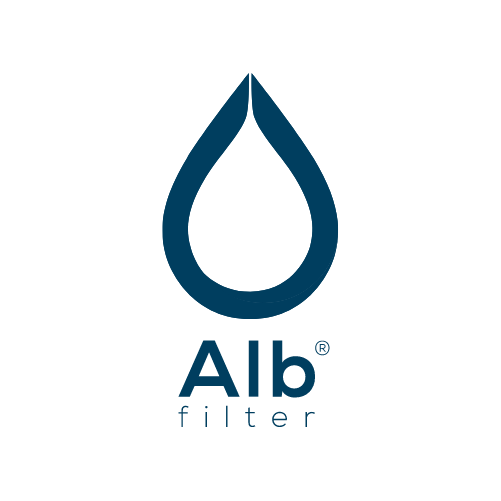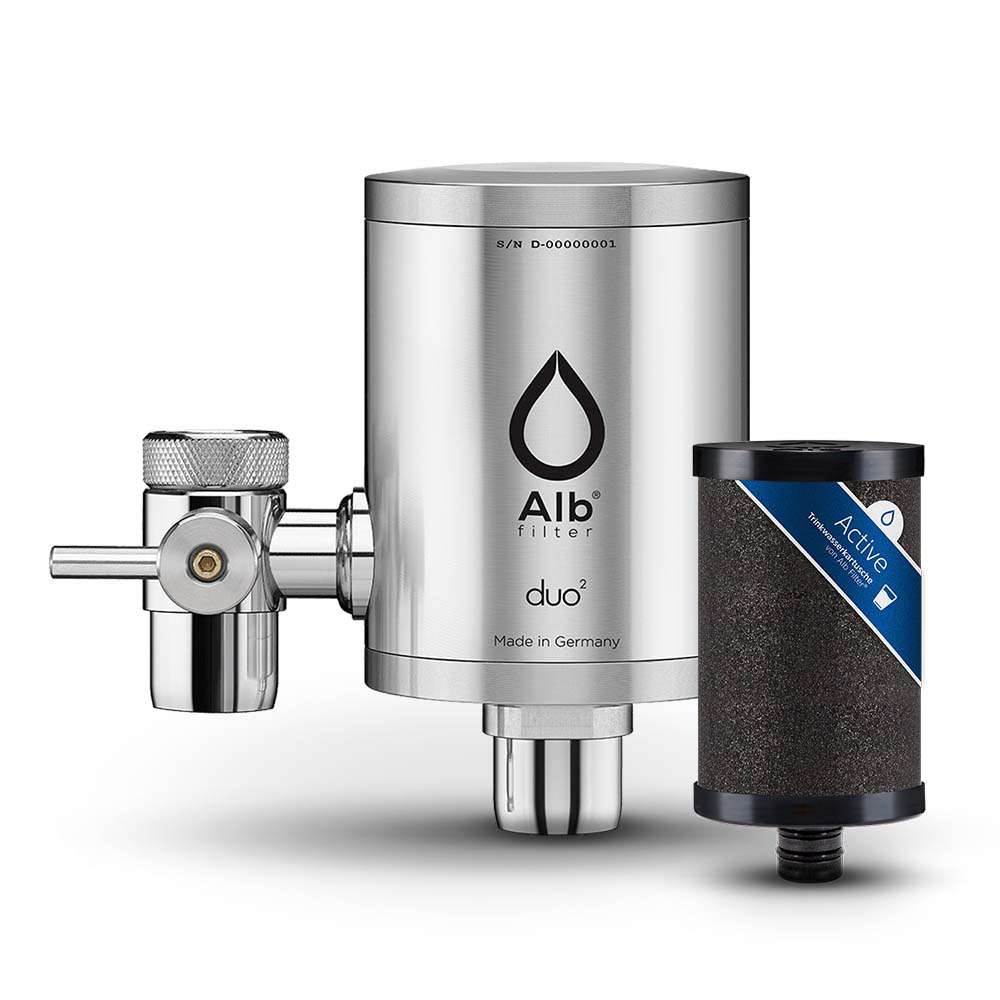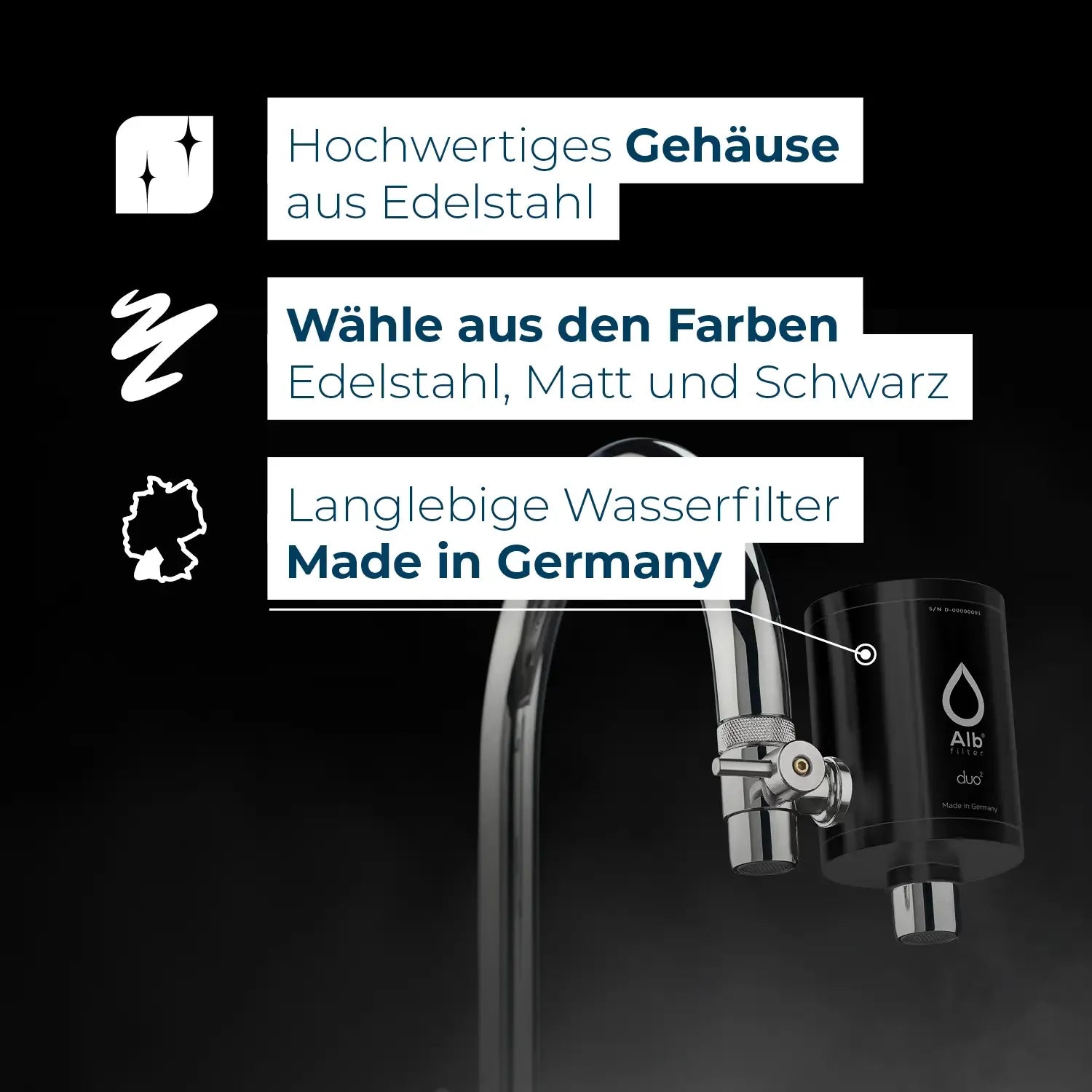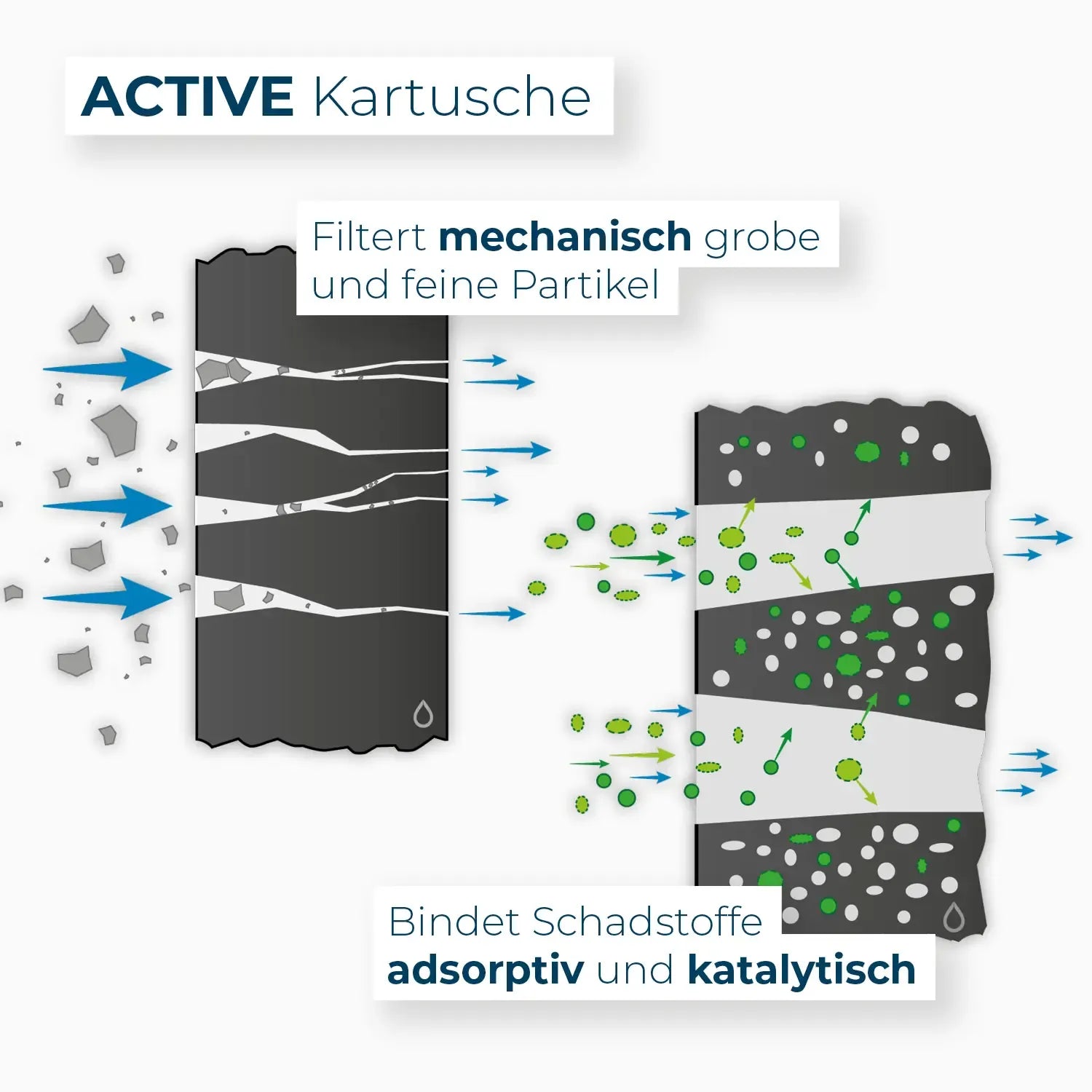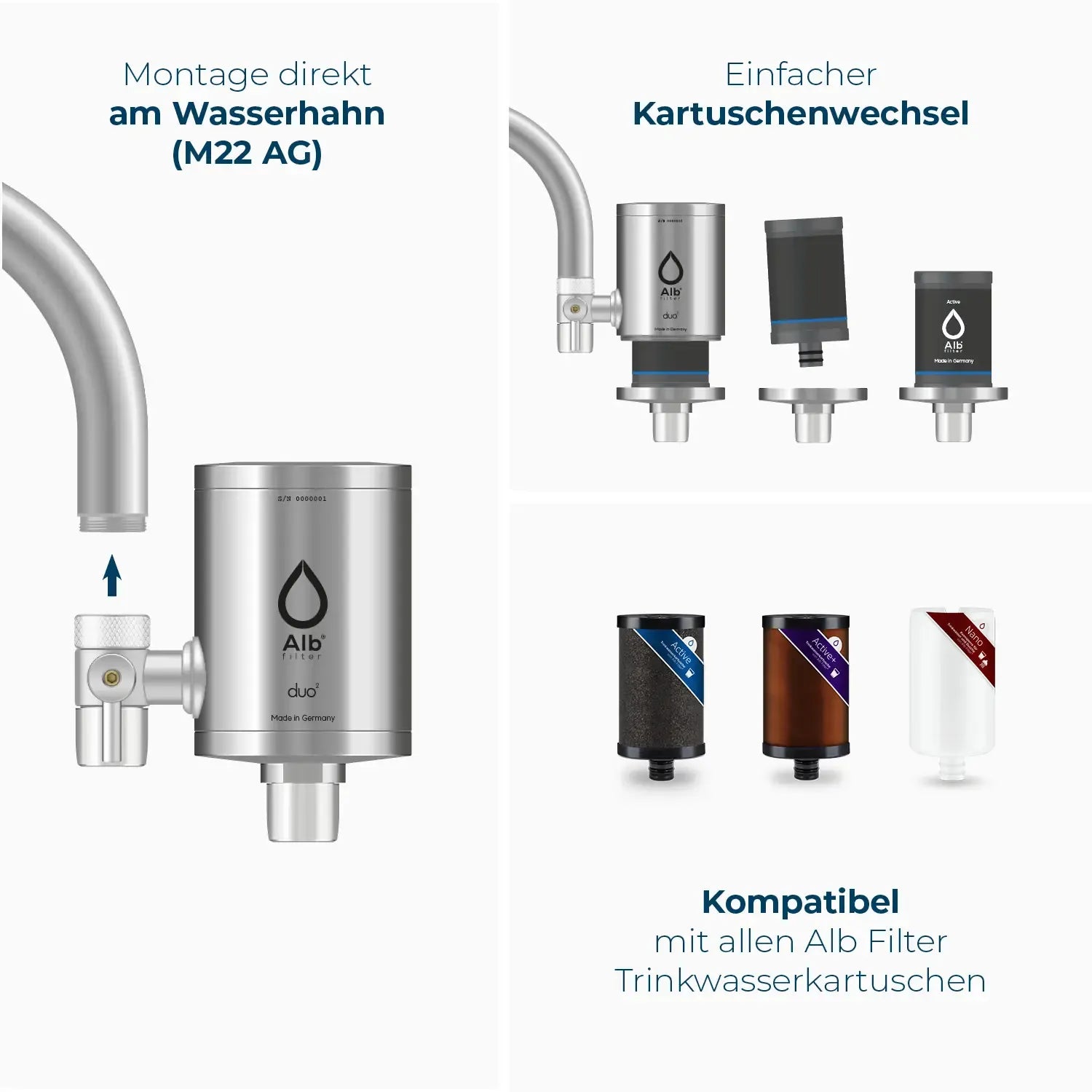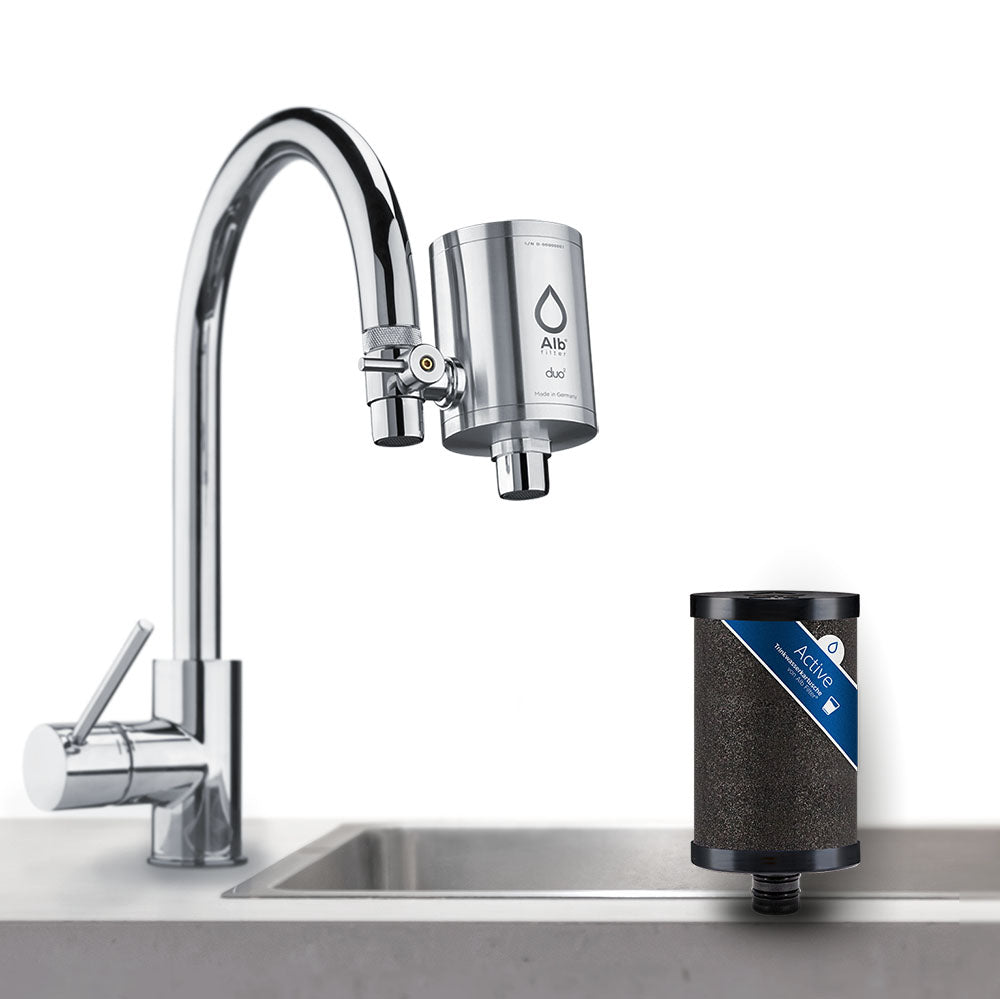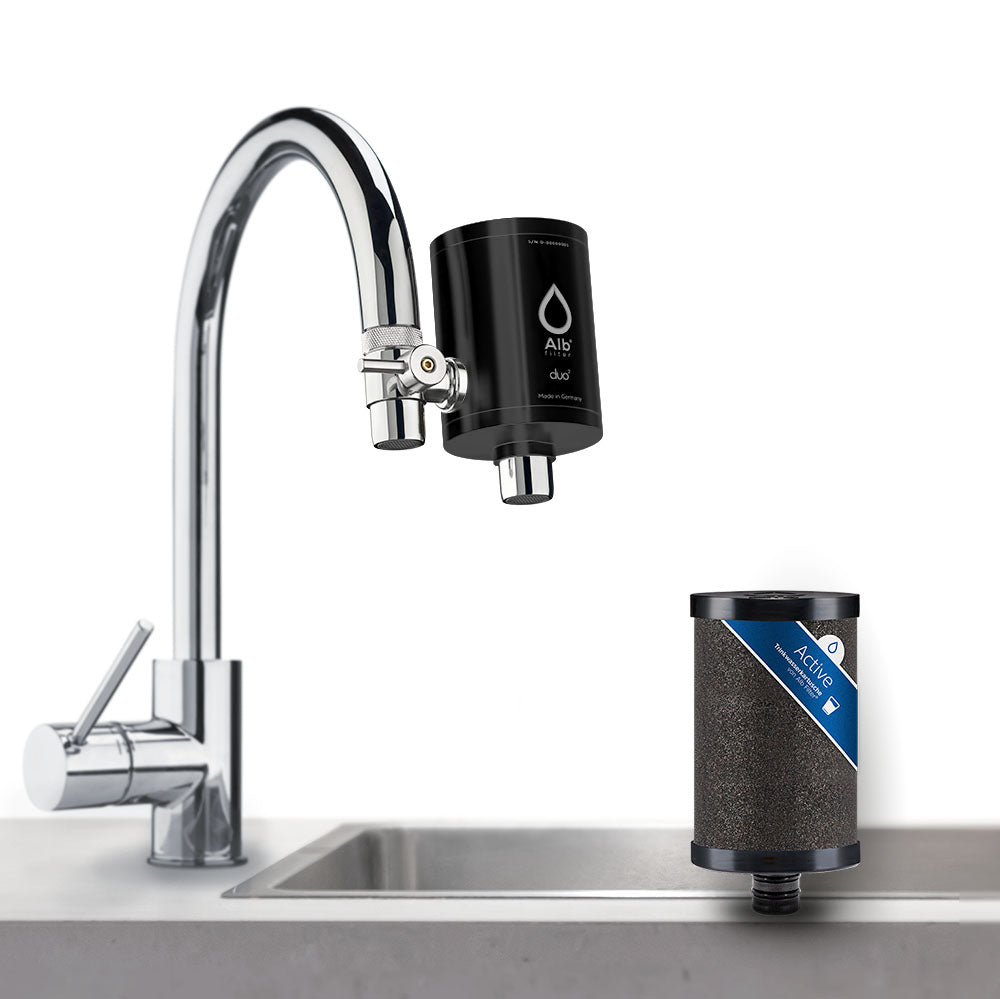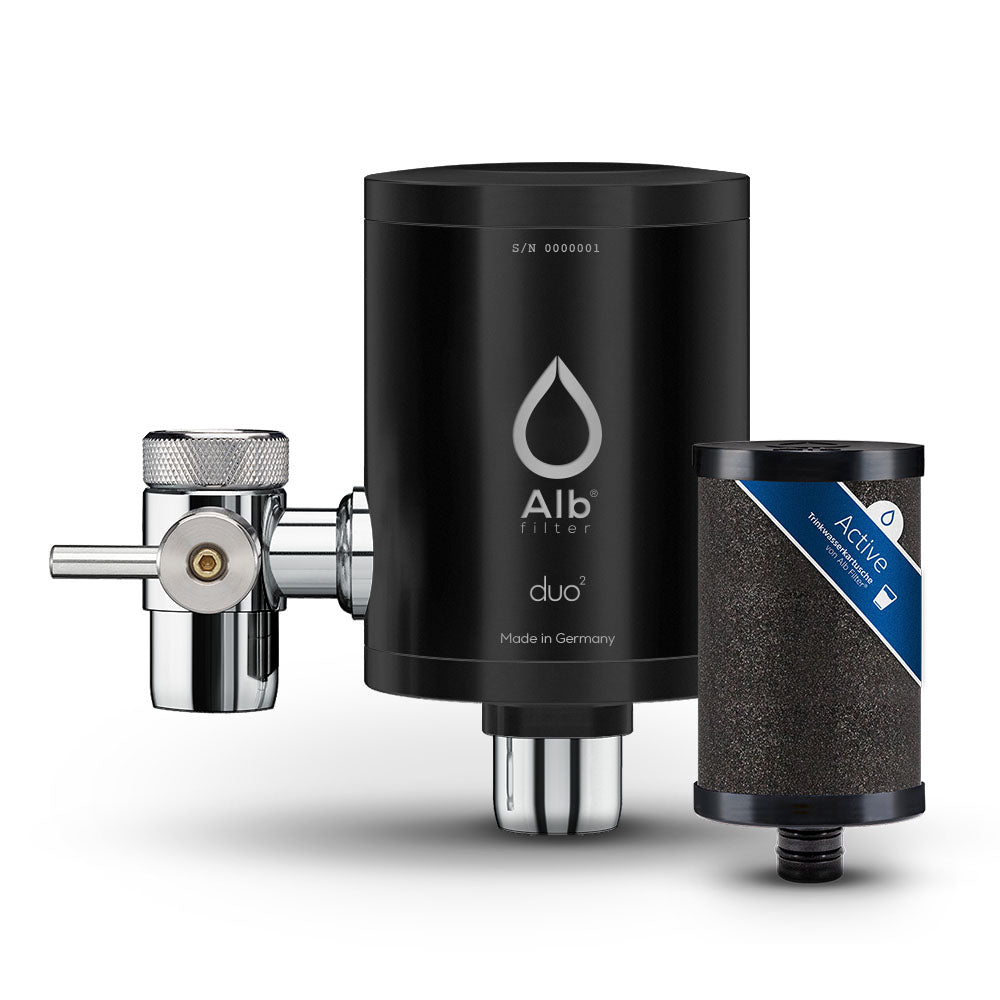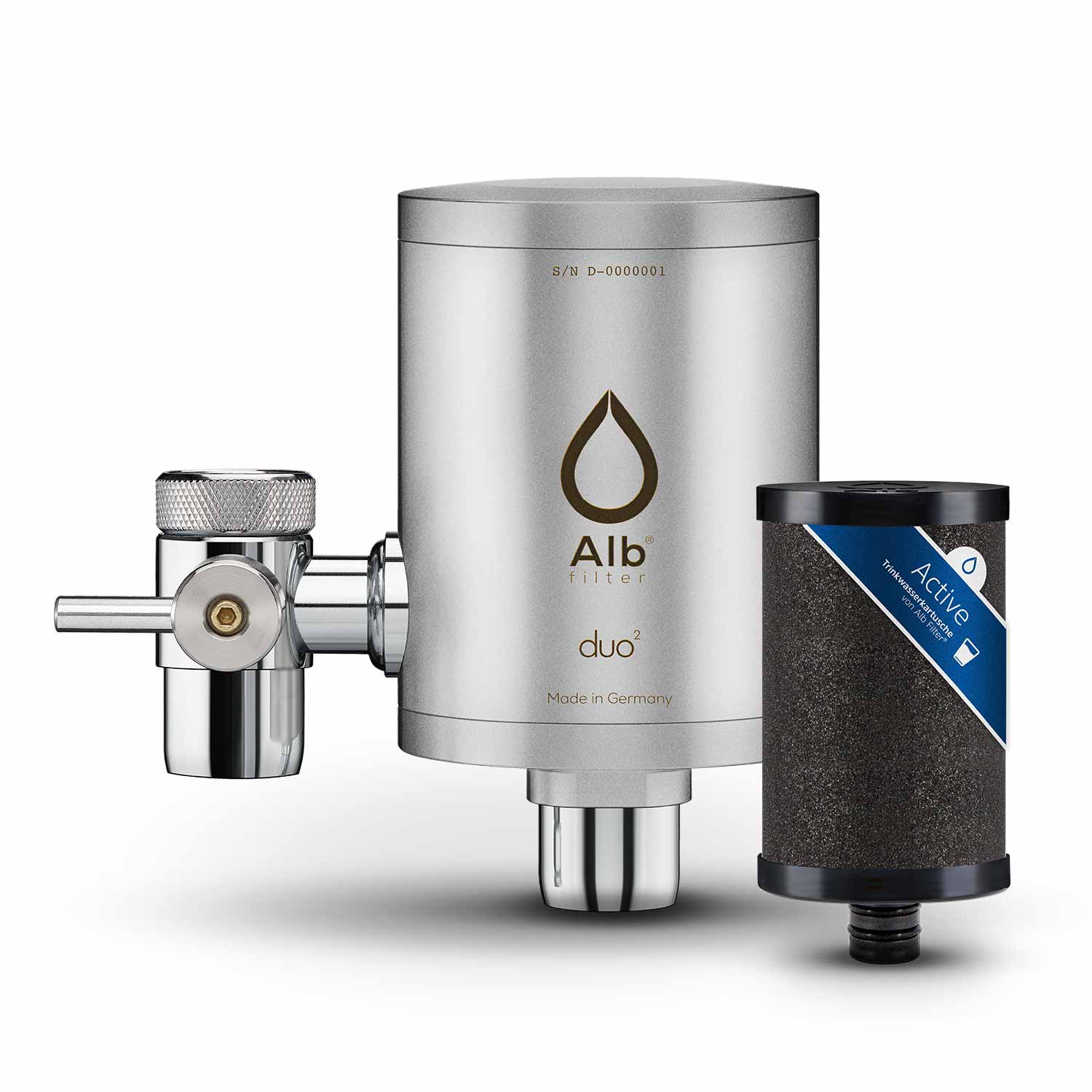Microplastic filter for drinking water

The health risks posed by microplastics are a hotly debated topic and are a concern for many people. However, if you clean your water with a suitable microplastic filter, you no longer have to worry about plastic residues in Tapwater : thanks to innovative technology, consumers are now offered powerful water filters that reliably protect against microplastics in drinking water .
Find out in this article…
- why microplastics – especially the pollutants attached to them – pose a health risk in drinking water.
- what methods and techniques are available to filter microplastics.
- why we at Albfilter rely on activated carbon block filters.
- how microplastics get into your drinking water tap in the first place .
- and how to remove microplastics from your Tapwater can filter.
The scientific article states:
Quote
“The microscopically small synthetic abrasives and textile fibers are discharged into the sewage system via wastewater disposal and are only partially retained by conventional sewage treatment plants. A large proportion ends up on agricultural land via sewage sludge, where they are hardly or only very slowly broken down.”
Even in German organic waste, plastic appears and ends up on the fields together with sewage sludge, where it then finds its way into drinking water and can currently only be removed with a microplastic filter.
Excursus:
What is the difference between primary & secondary microplastics?* [Shortfacts]
Primary microplastics

Definition:
Small plastic particles that are used as material in industry and trade.
- In cosmetics, e.g. peelings & toothpaste.
- In medicines & cleaning products.
- In varnishes & paints.
- In coating agents for textiles & citrus fruits!
Secondary microplastics

Definition:
Accidental product that arises through chemical and physical processes.
- Wave movement and UV light decompose plastic waste into microplastics.
- Abrasion from (car, truck) tires is the largest source of microplastics.
- Fibers from plastic clothing (when washing clothes) become secondary microplastics
- This particularly applies to clothing made of polyester, polyethylene and elastane.
Official limits for microplastics in drinking water?
The WHO's current position on the issue of microplastics in drinking water is ambiguous. On the one hand, the World Health Organization does not currently see microplastics in drinking water as a health risk for humans. On the other hand, it is still unclear to biologists and doctors to what extent microplastic particles cause damage in the body , for example by allowing toxic substances to enter the bloodstream. 3
A common misunderstanding is that it is not always about the microplastic itself. Rather, pollutants that adhere to the plastic are also suspected of causing damage to the genetic material and hormone balance - such as pesticides, dioxins, polychlorinated biphenyls and other environmental toxins . This is because microplastics are a "magnet" for various pollutants due to their chemical properties. 4
This is probably one of the reasons why the WHO clearly advocates the need for further research . 5
Actually, it would be the task of the German Drinking Water Ordinance , which is responsible for ensuring the quality of drinking water in Germany . However, it only includes limit values for around 50 possible pollutants. Industry, agriculture, the environment and humans also introduce many other substances into the water cycle that are not taken into account by the ordinance - including microplastics and plasticizers such as bisphenol-A.
The good news? At the end of 2020, the EU imposed Europe-wide limits on some substances in drinking water, including the plasticizer bisphenol-A and microplastics. 6
What is microplastic? How is it defined exactly?
How exactly is microplastic defined?
Plastic particles are considered microplastics if they have a diameter of less than 5 mm (5000 micrometers). But they can be much smaller: many plastic particles are in the micro or nanometer range and can therefore only be seen with a microscope .
Good to know
In general, plastic particles with a size of 0.1-5,000 µm (0.1 µm – 5 mm) are considered microplastics. A sheet of paper at 100 µm is about 1000 times thicker than the smallest plastic particles at 0.1 µm. The largest microplastic pieces are 5 mm, which is about the average length of a red ant.
Furthermore, microplastics are just the general term for any plastics (= polymers) in the chemical industry. They are also called long-chain hydrocarbon compounds and are used in many products. For example, microplastics can be found in toothpaste and many cosmetics.
Ordinary plastic waste must first be broken down into its microscopically smallest pieces by external influences – UV radiation, friction, currents – and this is how microplastics are created.
How drinking water filters reliably protect against microplastics
Microplastics are therefore omnipresent and represent a diverse environmental burden. Since a possible harmful effect on human health cannot yet be ruled out, many consumers want a microplastic filter so that they can enjoy their drinking water as plastic-free as possible.
While research is exploring new ways to remove microplastics in the treatment of wastewater to protect the environment, microplastic filters offer a protection option for private households. Good water filters work completely without chemicals and reliably protect against microplastics.
What methods are there for filtering microplastics?
In principle, many filter media can be used to filter microplastics – e.g. activated carbon, ceramic, hollow fiber membrane or UF membrane. The smallest in the Tapwater The microplastic particles measured in the Orb Media study mentioned above were about 2.5 micrometers. Therefore, a water filter should also be able to filter nanoparticles of this size. 7
Reverse osmosis filters, ion exchange filters and activated carbon filters are commonly available as water filters for private use.
What do reverse osmosis filters and ion exchange filters do?
Reverse osmosis filters and ion exchange filters are very efficient. They filter out the smallest microplastic particles up to a size of 0.001 micrometers , but they also have disadvantages: The filter systems are not exactly cheap and are difficult to install. In most cases, a tradesman is required for installation.

Disadvantages of reverse osmosis filters and ion exchange filters
In the study mentioned (Orb Media), of all the plastic particles found in drinking water, there were only two pieces that were smaller than 1 micrometer.
Anything smaller than 1 micrometer is referred to as a nanoplastic particle. They are also microplastics, but for physical reasons they can no longer be filtered out by activated carbon filters, for example. Researchers also assume that nanoplastics are more likely to be absorbed through the skin or the air in the room than through drinking water.
If you still want to filter out nanoplastic particles, you can try using a reverse osmosis filter or ion exchange filter . Both remove microparticles at the smallest microscopic level. The disadvantage: This is usually accompanied by a deterioration in water quality , as valuable substances such as salts and minerals are also lost in addition to the microplastics.
What do (different) activated carbon filters do?
Usually, a distinction is made between two types of activated carbon filters that can filter microplastics in the necessary size (~2µm):
- Filter with granulated activated carbon: This filter medium removes most of the microplastics from drinking water up to a size of approximately 5 micrometers (µm).
- Activated carbon block filter: This filter medium removes microplastic particles slightly more efficiently up to a size of 2 µm.
An activated carbon block filter is best suited for the consumer because it combines more advantages and does not require complex installation.

Advantages of (sintered) activated carbon block filters
Since it can be assumed that the size of microplastic particles in drinking water is mainly between 2-10 micrometers, there is much to be said for the use of activated carbon block filters to remove microplastics from the Tapwater to filter reliably.
Activated carbon has what are known as adsorptive properties and can therefore bind hydrocarbon compounds. Activated carbon block filters also have the advantage that they are mobile and can be connected to locations with poor water quality . They also filter many other pollutants - e.g. drug residues, pesticides, heavy metals, etc. - out of the water without affecting the quality of the drinking water.
The sintered activated carbon developed by Alb Filter in particular has an extremely high porosity, which means that particles between 1-2 micrometers are reliably removed.
How does microplastic get into my drinking water pipe?
The pathways through which microplastics enter mineral water and Tapwater are not fully researched. However , practically every private household also contributes to the spread of microplastics:
- Every time a sweater that contains polyester is cleaned, microplastics are washed out.
- The daily abrasion of car tires also causes enormous amounts of microplastics to enter the water, especially after rainfall.
- However, wastewater is not sufficiently filtered of microplastics before it is “clarified” and makes its way back into lakes and rivers
Microplastics, which enter the water indirectly, also play an important role . The particles often first enter the atmosphere through abrasion processes and later enter the water through rain and snow.
Microplastics also get back into the water cycle through sewage sludge that is spread on agricultural fields, as Martin Wagner from the Norwegian University of Science and Technology (NTNU) in Trondheim discovered.
You can read more about microplastics in Tapwater here.
How much microplastic is in our drinking water?
A large-scale study by the Alfred Wegener Institute (AWI) in 2014 found that there are between 86 and 714 microplastic particles in one cubic meter of water . Almost all German sewage treatment plants are overwhelmed by microplastics. Depending on the size of the plant, an estimated 93 million to 8.2 billion microplastic particles end up in our rivers. (Source: Ingenieur.de)
Such findings are supported by the aforementioned global study conducted by the University of Minnesota together with Orb Media , a non-profit journalist network. The research team analyzed over 150 drinking water samples worldwide.
The result? 80 percent of the water samples contained microplastics , although the proportion in Germany is considerably lower than in other countries. Two and a half particles were found floating in one liter of water in samples from Hamburg and Dortmund. With the exception of two nanoparticles, all other microplastic particles were larger than 1 micrometer .
How do I protect myself from microplastics in water?
Since microplastics are a major problem in wastewater, research is continuing in large institutes. Research teams are currently working on innovative, high-performance cyclone filters to thoroughly remove microplastics from wastewater.
What can you do about it? You can Tapwater First of all, test to determine whether and how much microplastic is in your drinking water.
How can I test whether and how much microplastic is in my drinking water?
The growing plastic problem is motivating not only professional filter manufacturers and scientists, but also the younger generation. Several school projects have produced smart ways to filter microplastics at home .
The most recent national prize from Jugend Forscht went to fifteen-year-old Leonie from Friedberg near Augsburg, who invented a water filter for the washing machine drain . This filters the microplastics using inexpensive materials from the hardware store. 8
And if you want to see the plastic beads in the peeling cream, you can do so with two layers of tea bags .
For the test on Tapwater All you need is an efficient drinking water filter that reliably protects against microplastics in drinking water.
mineral water instead Tapwater ?
What happens when you Tapwater and consistently drink mineral water ? Am I then avoiding the risk of drinking microplastics? Unfortunately, far from it!
Mineral water from plastic bottles can contain more microplastics than Tapwater The cause is believed to be the increasing brittleness of the inside walls of bottles . This can be avoided by using glass bottles. In general, we are exposed to microplastic particles more often in everyday life, as they are omnipresent in many objects:

- Plastic kettles also release microplastics.
- Stainless steel appliances can help here.
- Tumble dryers spread microplastics by spinning clothes with high plastic content.
- Microplastics are found in many cosmetics .
- Plastic bottles can contain more microplastics than Tapwater .
Remove microplastics from water: with microplastic filters Made in Germany
Microplastics therefore pose a diverse environmental hazard . Possible effects on the human organism are still the subject of research. So far, there is much to be said for effectively protecting people from microplastic particles (which may be hazardous to health and are also harmful to the climate).

With drinking water filters for private use, you get easy-to-install, highly efficient filters that not only remove microplastics from the Tapwater Activated carbon block filters in particular help you to obtain clean drinking water that is free from unwanted environmental or toxins. Valuable minerals, salts and trace elements remain - unlike with osmosis filters - despite the filtering.

Frequently asked questions explained briefly
Can microplastics be filtered?
The size of microplastic particles in drinking water is between 2-10 micrometers. All filters that have a smaller pore size can remove these plastic particles from drinking water - such as the activated carbon filters from Albfilter.
How can water filters filter microplastics?
Microplastic particles in drinking water are usually larger than 1-2 micrometers. These can still be seen with the naked eye. Those smaller than 1 micrometer are called nanoplastic particles, which can only be seen under a microscope.
Is in Tapwater Microplastics?
A study by the Alfred Wegener Institute (AWI) in 2014 found that there are between 86 and 714 microplastic particles in one cubic meter of water . Between 93 million and 8.2 billion particles end up in German rivers and can therefore also find their way into the Tapwater find.
How much microplastic is in drinking water?
A study by the University of Minnesota analyzed over 150 drinking water samples worldwide. The result? 80 percent of the water samples contained microplastics , although the proportion in Germany is considerably lower than in other countries.
How do microplastics get into drinking water?
The ways in which microplastic particles get into Tapwater have not been fully researched. However, practically every private household contributes to the spread of microplastics - for example, by washing clothes with synthetic materials.
Related articles and products
References
- www.dw.com/de/study-microplastic-contaminates-our-all-drinking-water/a-40369697
- cvua-mel.de/index.php/aktuell/138-analyse-of-microplastik-in-food-and-cosmetics
- www.deutschlandfunk.de/riskfactor-microplastik-was-machen-kunststoff-partikel-im.676.de.html?dram:article_id=450827
- www.sueddeutsche.de/wissen/umwelt-mikroplastik-wie-ein-magnet-fuer-schadstoffe-1.3103999
- www.deutschlandfunk.de/microplastik-im-trinkwasser-umweltmediziner-who-zweit.676.de.html?dram:article_id=457042
- https://www.bundesgesundheitsministerium.de/presse/pressemitteilungen/2020/4-quartal/trinkwasserrichtlinie
- https://orbmedia.org/invisibles-final-report
- www.bayern3.de/leonie-prillwitz-microplastik-filter-augsburg

